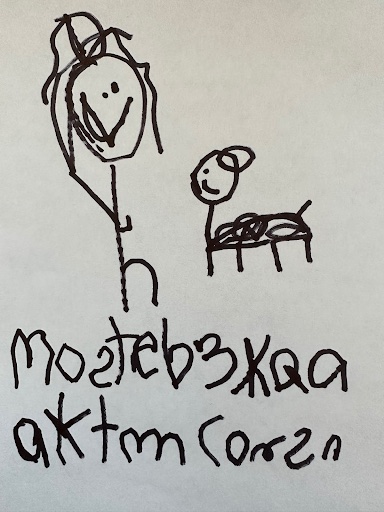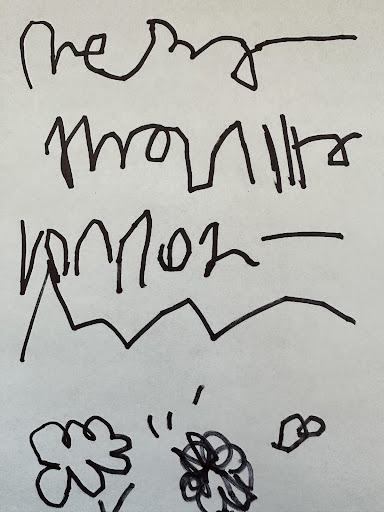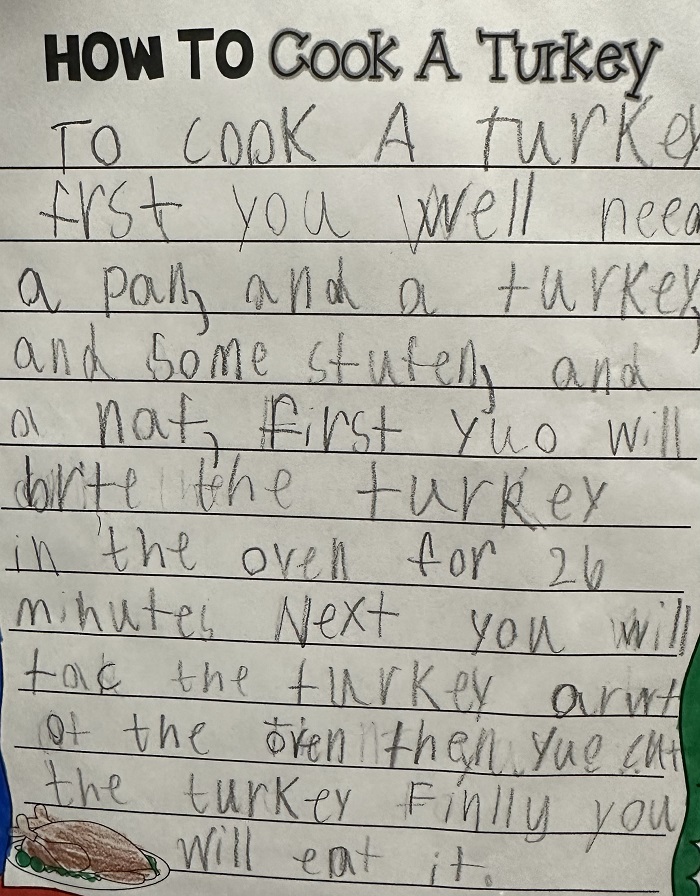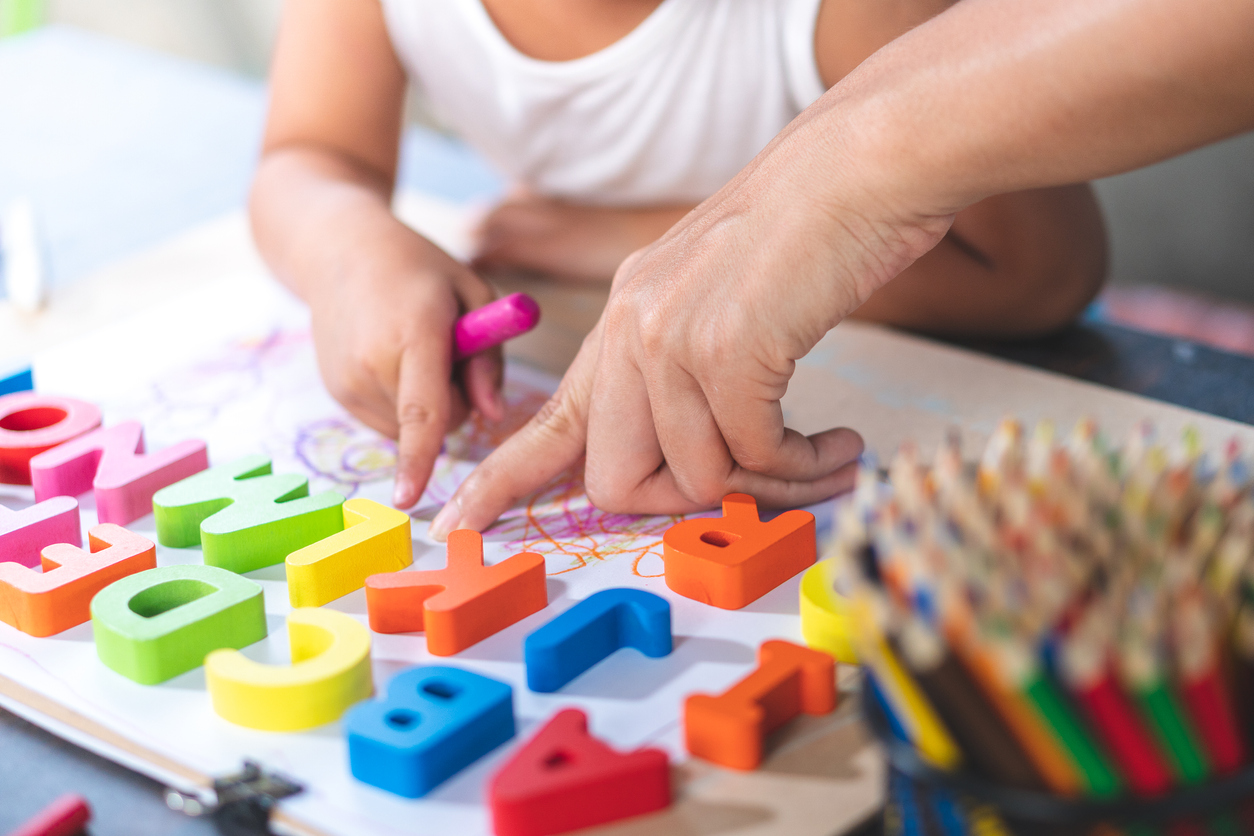My Child is Writing Backward: Do They Have Dyslexia?

A common question I receive as a reading specialist surrounds the concern a parent may feel when their child is reversing letters, forming letters in mirrored images or upside down, or making number reversals.
Parents often want to know if this writing behavior is a sign of dyslexia and what to do to best support their child’s literacy development.
My first thought upon hearing this question is an appreciation for the parent who is noting the developmental changes in their child’s literacy skills. This engagement with your child’s development will play a key role in their literacy success.
Let me put your mind at ease, writing letters backward is not an indicator of dyslexia in young children. As with most complex issues, there are nuances in this question that are worth addressing.
Related: Is It Time to Check for Dyslexia?
Let’s explain why some kids write backward while learning to read and write and share other factors or signs of reading difficulties or dyslexia in children.
What is Dyslexia?
The International Dyslexia Association defines dyslexia as, “a language-based learning disability.” Dyslexia typically includes varied symptoms that affect language skills, most commonly, reading.
Children with dyslexia often exhibit difficulties with other language skills such as writing, letter retrieval, pronunciation, and spelling.
What You Should Know About Dyslexia in Kids
The misunderstanding about common letter reversals in written expression likely exists because dyslexic readers and writers typically have trouble with word and letter retrieval and connecting letters' names and sound with their appropriate symbols. This may be manifest in inaccuracies in their written expression.
In her book “Overcoming Dyslexia” Dr. Shaywitz explains, “While it is true that dyslexic children have difficulties in attaching appropriate labels or names to letters and words, there is no evidence they actually see letters and words backward.” Letter reversals are considered to be a common occurrence and part of the process of learning to read and write.
It is important to dispel this myth as there is a danger to thinking letter reversal, mirror image writing, and upside down/flipped lettering should lead to a dyslexia diagnosis.
Misunderstanding the letter reversal issue may lead some students who exhibit common letter reversals, flipping, or mirroring to be incorrectly deemed dyslexic.
Conversely, for a child who is dyslexic, other red flags may be overlooked if a child does not exhibit this behavior. The only way to receive a diagnosis of dyslexia is to have a professional assess and evaluate your child using multiple measures.
Developmental Stages for Reading and Writing

As your child learns to read and write, they will move through different stages of literacy development. While each child may move through these stages at varying rates, parents should expect to see certain benchmarks.
Harvard professor and researcher, Dr. Jeanne Chall (1996), discussed key early reading stages in her research. These early literacy stages are as follows:
Emergent Literacy (Preschool to 5-year-old)

The child shows attention and interest in language (reading, writing, listening, speaking). Expect to see your child begin to develop phonological awareness. Phonological awareness provides the bedrock for reading development.
It is the ability to recognize, work with, and manipulate sounds in spoken language. Hopefully, you will begin to see your preschool-aged child blending, stretching, rhyming, and working with words in new ways.
- Writing at this stage may look like scribbles, waves, or drawings
- Children may copy symbols they see around them
- Some children may write a number in a string of letters at this stage.
- By preschool most children have picked a dominant hand (right hand or left hand) and often grasp the pencil/crayon with a fist early in this stage.

As young children begin to form letters and express themselves through writing, you may see common letter reversals.
Early Reading (Grades K-1 or 5 to 7-years-old)
The biggest shift in this stage comes when children begin to understand the alphabetic principle. Children begin to develop and employ the understanding that there is a 1:1 correspondence between sounds and letters.
Children will use this knowledge to begin to decode words. Quality phonics instruction during the early reading stage is important for success in reading.
Writing at this stage may look more conventional, groups of letters/whole words (likely with a focus on consonants) will be present, and letter/sound correlations may be more prevalent. Fine motor skills and letter formation improve as well.
Growing Independence (Roughly Grades 2-3 or 7 to 9-years-old)
At this stage, you will see students becoming more automatic with decoding (not having to spend as much time sounding out words), and they will likely have a bank of sight words.
They will begin working on reading fluency and will gain more sophisticated word-attack strategies. Comprehension skills become more refined.

Writing at this stage will show stronger letter sounds matches. The child now understands that vowels are needed to make words and will represent each sound in a word when writing (even if the spelling is unconventional, such as /fone/ for /phone/).
Fine motor skills continue to strengthen and letter formation continues to improve.
(While there are several other stages of literacy development, as we are focused on early stages and risk factors for dyslexia, I will stop at this level.)
It is important to think of these stages on a continuum and not as discretely concrete. While one child may read in kindergarten, another with the same access and support may not read until the following year. While there is differentiation within each stage, if your child is not beginning to read by age 6-7 years old there is cause for concern.
When Should I Worry About Dyselxia?
If you see the following issues arise in your child’s development, it may be time to reach out for help or support.
This is not a definitive list, rather, where I tell parents to begin their search as they work to find answers to their concerns surrounding literacy development.
Any one item on this list does not constitute a diagnosis of a learning disability or learning difference. If you have concerns in these areas, it may be cause for further investigation, or possible testing to determine the best path forward.
Reading and Writing Developmental Milestones / Benchmarks
As you take your child in for regular well-visits, talk to your pediatrician (or pediatric specialist) about developmental milestones. Note any worries you have surrounding language, reading, or writing development with your physician.
This can be a good starting point to determine if your child’s development and behaviors are appropriate for their age. Regular well-visits will also rule out other factors such as vision, hearing, or fine motor skills that can affect language development.
Early intervention with the support of your pediatric care team (pediatrician, occupational therapist, speech therapist, etc.) is important for children who may not be meeting developmental milestones.
Speech Delays
One of the first indicators of a learning difference, such as dyslexia, is a speech delay. Talk to your doctor or pediatric specialist if you suspect any delays or regressions in speech. To be clear, a delay in speech does not mean your child has dyslexia.
Some children who are later diagnosed with dyslexia did not manifest speech issues in their early development. Regardless, a speech delay is an early indicator that something may not be right and attention in this area is needed.
Phonemic Awareness: Rhyming and Distinguishing Patterns
As you talk with, listen to, and play with your child, take note of your child’s language development. Watch for (and support) phonemic awareness behaviors and activities. In preschool, most children can differentiate words that rhyme and patterns within language.

It would be important to note if your child is unable to decipher rhyming words, or has trouble with phonemic awareness activities at this stage of development.
Can your child take apart and play with language in meaningful ways? You might work with your child at home on activities and questions like: “Can you make the sounds that are in the word, cat?” or, “What two words make up the word freeway?”
Letter and Word Retrieval
Letter and word retrieval issues can also be a risk indicator for dyslexia. Does your child have difficulty remembering the names of letters or numbers, remembering the names of things, or pronouncing longer words (sometimes jumbling or confusing the sounds in these words)?
For example:
If a child has studied a letter-sound relationship, used that sound repeatedly, and still has trouble retrieving that sound when asked, this would be something worth noting. As you see patterns of letter retrieval difficulties over time, this may be a possible area of concern. It may be time to talk with your child’s teacher.
Does your child have trouble remembering the letters in their name?
While letter and word retrieval issues are a condition of worry, when children learn sound-symbol relationships, retrieval can be slow for many reasons.
When a child does know a sound and is repeatedly left pausing, “umm, um, um-ing, ” or searching for the sound, it can add to your portfolio of concerns.
Phonics Instruction
Find out if your child’s school is teaching phonics explicitly. I recommend asking about the primary reading program and methodology your school uses for early reading instruction. You want to know that your child is systematically and explicitly taught phonics.
It is not enough to teach phonics skills when the need arises, with worksheets only, or as remedial instruction for students who are behind or need extra attention in reading.
Long-held standards for preparing children to be successful readers, currently referred to as The Science of Teaching Reading, suggest that phonics instruction is best practice. If your child is not receiving phonics instruction in school, this is cause for concern and could play a part in your child’s struggle to read.
Family History of Dyslexia
While many factors may come to bear when diagnosing dyslexia, a family history of dyslexia or reading disability puts a child at greater risk for reading differences such as dyslexia.
A study conducted by Smith, Brower, Cardon & Defries (1998) concluded that children whose parents experienced struggles with reading are 3-6 times more likely to experience issues surrounding reading.
Frustration Learning to Read
When a child is continually and significantly frustrated with reading and writing, it is time to intervene and check to see if there is a larger issue. It is not helpful for a student to regularly feel discouraged or defeated when presented with a text or writing activity.
No matter the root cause, if a child is continually frustrated with reading or writing, it is time to ask the teacher, support staff, or pediatrician for help.
A Final Note
In my experience, parents often have an innate sense when something is wrong with their children. If you find yourself reading this article because you are concerned about your child’s literacy development, don’t discount those feelings.
Early intervention for students who are struggling with reading is important. If you feel your child needs help, ask for support. When addressing delays in development, early intervention is always the best practice.
Dyslexia is a complex issue faced by many children. Fortunately, with support, intervention, and quality instruction, dyslexic readers often find themselves back on the road to success in reading and writing.
Shelly D. Smith, A. M. Brower, L. R. Cardon, and J. C. DeFries. Genetics of Reading Disability: Further Evidence for a Gene Chromosome 6. in D.D. Drake (Ed.) Reading and Attention Disorders: Neurological Correlates. 1998. pp. 63-74.

